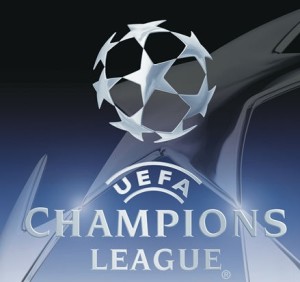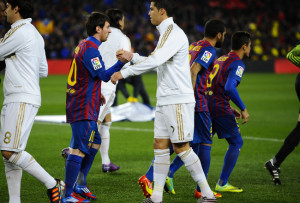Champions League Betting Basics
 The UEFA Champions League is the biggest competition in club football and in fact has come to overshadow national domestic leagues, such is its importance in terms of both prestige and financial reward.
The UEFA Champions League is the biggest competition in club football and in fact has come to overshadow national domestic leagues, such is its importance in terms of both prestige and financial reward.
Watched around the world, the Champions League pits Europe’s best club sides against each other with the victorious team being awarded the revered European Cup.
It’s massively popular with football betting fans the world over, but the bookies know this, and tend to set their odds very tight in Champions League matches. Nonetheless, here’s a beginners’ guide to how the competition works.
First awarded in 1955, the European Cup competition followed a knock-out format much like the National cups in the participating countries until 1992. From there, UEFA adopted a round robin structure and the league expanded to accommodate more teams and rebranded the competition.
Initially, the move to a league structure was criticised as it was felt that it diluted the grandeur of European Cup matches, but since then format has become widely accepted and across the World, Tuesday and Wednesday nights between August and May are synonymous with Champions League football for fans of the game. Initially, the Champions League was an exclusive tournament only contested by the champions of Europe’s domestic leagues, but has expanded such that up to four teams from certain country can appear in the group stages.
The Champions League is the one they all want to win, so teams will always field their strongest available line-up for the matches.
Qualification for the Champions League
The League proper begins with 32 teams arranged into eight groups, however determining how the groups are made up is a somewhat convoluted process due the number of member countries and their varying standards of play.
Before the tournament proper begins, there are a number of qualification rounds to give clubs from lower ranked countries an opportunity to qualify. The most important parameter in deciding how the group stages are made up is the ‘UEFA coefficient’ which is basically a measure of each member country’s success in European competition in recent years. The place at which a country is seeded in the rankings determines how many clubs they can enter, and at what stage these clubs enter the competition.
England, Germany, and Spain typically occupy the first three places and so they are awarded four places in the tournament, with three teams going directly into the group stages and one entering the final playoff round.
Second tier countries like Italy and France are given two places in the group stages with one place in the the final playoff round. This continues down the UEFA rankings to countries like Northern Ireland and the Faroe Islands, who are given one place in the first qualifying round (there are three rounds before the final playoff).
All qualification games are played as two legged ties with home and away legs, with the winner being decided on aggregate score over the two matches. In the event of a tie, the team that scored more goals away from home is deemed the winner, and should this not break the tie, the game goes to extra time and penalties. An interesting anomaly occurred in 2006, where defending champions Liverpool did not qualify for the following years competition by finishing high enough in the English Premier League, however an exemption was made for them.
Format of the Champions League Tournament
The draw for the group stages takes place in Autumn and is seeded into 4 pots such that top ranked teams cannot be drawn in the same group as each other. The draw is further engineered so no two clubs from the same country can be drawn against each other. During group matches, teams are awarded three points for a win and one for a draw, with no points for a loss. If, when all group matches are complete two teams have the same points total, they are separated by goal difference (goals scored – goals conceded), and beyond that by goals scored.
At the end of the group stages the eight group winners and runners up qualify for the knockout phase in home-and-away ties, with a group winner playing a runner up from another group in each tie, again with the ‘away goals’ rule in play. Third placed teams are diverted to the Europa League, UEFA’s second club competition.
Again at the last-16 phase, clubs from the same country cannot play each other. This restriction is lifted for the quarter finals which are decided by means of an open draw. The final is played over a single leg at a stadium that is determined before the competition begins.
The format has been tinkered with extensively over the years, even trying out two group phases for the years 1999-2003. This format was seen as too drawn out and the competition has since reverted to the single group phase followed by the knockout rounds.
The winners, as well as being awarded the European Cup, are entered in the UEFA Super Cup where they play the Europa League winners, and the FIFA Club World Cup where they play the champions from other continents’ club championships such as CONMEBOL’s Copa Libertadores.
Neither of these trophies is seen as particularly prestigious and the Club World Cup in particlar is viewed mostly as a promotional exercise. It is often seen as a headache by managers as it involves tiring intercontinental travel in the middle of the season and the risk of injury to important players.
Champions League History
Since its beginning in 1992/93 the Champions League has grown and grown in popularity. The round robin format only entered at the quarter final stage in that first year, and eventual winners Marseille were denied the opportunity to defend their title due to a match fixing scandal in the French league.
The next three years were dominated by Italy, with A.C. Milan winning twice and Juventus winning in 1996. 1999 saw what was probably the most dramatic and exciting final in European Cup history, when Manchester United stunned Bayern Munich with two goals in injury time to win the tie 2-1 and claim the cup.
Liverpool fans however will disagree and claim that their stunning comeback from 3-0 against A.C. Milan in 2005 to win on a penalty shootout was the high point of the competition.
Since then the Champions League has belonged to Barcelona, with victories in 2006, 2009 and 2011. They also made the 2010 final but were stopped by Jose Mourinho’s Inter Milan side. Barcelona’s arch rivals Real Madrid were victorious in 1998 and 2000 but have yet to make a final since then. Since Marseille’s victory in the inaugural League, only Porto (2005) and Ajax (1995) have broken the dominance of teams from Spain, England, Italy and Germany.
TV Coverage and Sponsorship
The Champions League is a hugely marketable brand and a massive draw for TV audiences all over the world. Live Champions League matches are broadcast in over 70 countries and unlike domestic leagues, games are very often broadcast on terrestrial TV. For example in the UK, ITV carries most games as does RAI in Italy, TVE in Spain and TF1 in France. The 2009 final had a global TV audience in excess of 100m viewers.
In terms of sponsorship, the Champions League limits itself to eight official sponsors. Currently the sponsors are comprised of huge global brands like Mastercard, Sony, and Heineken. The distribution of TV money and sponsorship is such that the winning can expect to earn in excess of €50m for their feat.
Champions League Facts
-Spanish player Raul holds the Champions League appearances record with 144 for Real Madrid and Schalke 04
-He also holds the goalscoring record with 71
– Lionel Messi is the only player to score 5 goals in a single match in the Champions League era, a feat acheived against Bayer Leverkusen in 2012.
-The largest margin of victory in the competition proper is Liverpool’s 8-0 victory over Besiktas in 2007/08.
-Bayern Munich hold the two-leg record, having beat Sporting CP 12-1 on aggregate in 2008/09.


